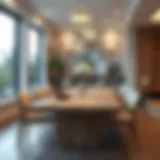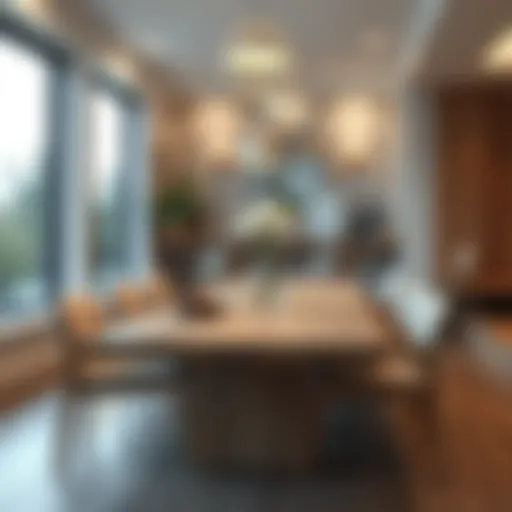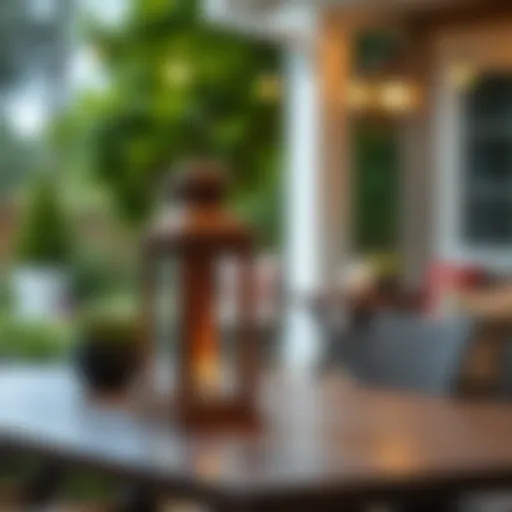Innovative Pot Organizer Ideas for Better Space Use
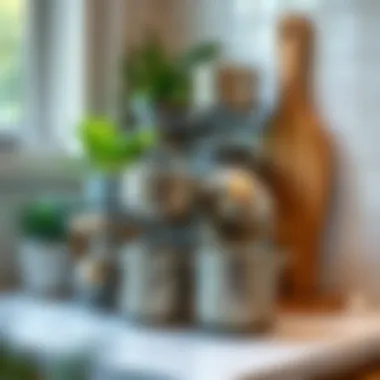

Intro
In today’s bustling world, where every inch of living space matters, the quest for efficient pot organization is both a challenge and an art. Homeowners and decor enthusiasts alike find themselves grappling with the clutter that indoor gardening can create. Be it a small apartment or a sprawling house, the quest for functionality without sacrificing style is crucial.
This article sheds light on innovative solutions for pot organization, catering not only to the practical needs of the space but also elevating the overall aesthetic of the home. From DIY projects that inject personality to sophisticated storage systems that whisper elegance, we’ll explore a variety of ideas designed to fit a range of tastes and budgets.
Furniture Styles and Trends
Modern vs. Traditional: Understanding the Aesthetics
The current landscape of interior design showcases a delightful dance between modern and traditional styles. Modern design leans heavily on minimalism, favoring clean lines and an open feel. In contrast, traditional styles bask in ornate details, rich woods, and classic colors.
So, how does this play into pot organization? Organizing pots can reflect the style of the surrounding furniture. For instance, using sleek, metal shelving units can resonate beautifully with modern decor, whereas a rustic wooden pot rack would be a perfect fit in a traditional setting. Combining these styles can also yield stunning results, creating a layered and personalized space.
Color and Material Trends: What's In and What's Out
The palette of a room speaks volumes, and incorporating pot organizers into this narrative can enhance the decor. Earthy tones are witnessing a resurgence, offering a warm and welcoming vibe. Natural materials, like bamboo and reclaimed wood, are also gaining traction, promoting sustainability while adding character.
On the flip side, overly bright and artificial colors are falling out of favor. Instead, soft, muted shades can complement both modern and traditional styles. Using neutral tones for pots allows for seasonal flexibility, inviting bursts of color as the seasons change, whether it’s vibrant flowers in spring or rich foliage in autumn.
Storage Solutions and Designs
Creative DIY Pot Organizers
Engaging with DIY pot organizers not only brings a personal touch but also allows for better space utilization. Here are some imaginative ideas:
- Vertical Gardens: Utilizing wall space with vertical planters made from pallets or hanging pots can transform any blank wall into a lush green canvas.
- Repurposed Furniture: Old dressers or bookcases can be converted into unique pot holders. A little paint and some creativity turn the mundane into extraordinary.
- Magnetic Spice Racks: These can easily double as a charming herb holder, making fresh ingredients readily accessible.
Sophisticated Storage Systems
When DIY isn’t on the cards, investing in well-designed systems can be worthwhile. Consider these styles:
- Tiered Plant Stands: Perfect for showcasing a variety of pots, while also saving space in tight corners.
- Hanging Baskets: They not only maximize vertical space but also create a striking visual element in any room.
- Sliding Shelves: For kitchens or balconies, sliding shelves can efficiently utilize cabinet space, making pots easy to access.
"The beauty of pot organization lies not only in functionality but also in the ability to create spaces that resonate with personal style."
End
Pot organization can indeed be a journey of transformation. By balancing aesthetics with practicality, homeowners can cultivate beautiful spaces that are not only functional but also a true reflection of their personalities. Striking a chord between modern and traditional, while embracing sustainable materials and inventive designs, will lead to smarter living spaces that breathe life into the home.
For further inspiration, check out platforms like Pinterest to see real-life implementations of these ideas. If you’re interested in more detailed information, refer to educational resources available at Encyclopedia Britannica.
Let your imagination run wild, and reclaim your space with thoughtful pot organization!
Understanding Pot Organization
Efficient pot organization is a crucial aspect of any home. It goes beyond merely finding a place to store items. The manner we organize our pots can influence everything from kitchen functionality to overall aesthetics. For homeowners, designers, and DIY enthusiasts, grasping the fundamentals of pot organization helps to maximize both space and ease of use.
The Importance of Efficient Storage
When it comes down to it, efficient storage serves as the backbone of a well-functioning home. Consider a cluttered kitchen with pots sprawled across surfaces. Not only does it create a visual mishmash, but it also transforms cooking from a joyful activity to a chaotic chore. Effective pot organization transforms this chaotic scene into a harmonized and orderly environment.
- Space Optimization: Storing pots efficiently frees up valuable counter and cupboard space. This ease of access means homeowners can prepare meals with fewer distractions. Moreover, a well-organized kitchen fosters creativity.
- Time-Saving: Knowing exactly where to find pots means less time rummaging through cupboards. An organized area means you can grab what you need in a heartbeat, ultimately making cooking less of a race against the clock.
- Aesthetic Appeal: A neatly organized space isn’t merely functional; it’s also visually pleasing. By presenting pots in an orderly manner, homeowners can create a beautiful focal point in their kitchens or living spaces.
In essence, when pots are organized, it simplifies many aspects of daily life. It encourages cooking, entertaining, and even cleaning, creating a smoother living experience.
Challenges in Organizing Pots
Like any task, organizing pots comes with its own set of challenges. Understanding these barriers is the first step toward finding innovative solutions.
- Variety of Sizes and Shapes: Pots come in different capacities, styles, and materials. This diversity makes finding a one-size-fits-all approach practically impossible. Additionally, nesting pots can take up even more space if not done correctly.
- Accessibility vs. Tradition: Many storage options, like cabinet shelving, may not guarantee easy access. Homeowners often find themselves stuck with pots they rarely use because they’re tucked away in hard-to-reach places.
- Aging and Wear: Cookware takes a beating over time. Pots may warp, accumulate stains, or even deteriorate, complicating organization as some might need to be retired altogether.
- Personal Preferences: Each person has their own method of functioning, making it tricky to meet the desires of all household members. What is ideal for one person may only clutter the space for another.
To tackle these challenges, it takes creativity and an understanding of one’s needs. By mapping out what works and what doesn’t, effective pot organization can become an achievable goal for any space.
Traditional Pot Organizer Concepts
Organizing pots efficiently is an essential part of maintaining a functional kitchen space. Traditional pot organizer concepts layout smart strategies aimed at optimizing the often limited space in cabinets and shelves. Understanding these concepts can lead you to make better choices regarding the storage systems in your own home, ultimately enhancing usability and improving the overall aesthetics of your kitchen.
With pots ranging in size and shape, the way you store them can significantly affect your workflow. For instance, a well-organized pot system not only saves you time but also minimizes frustration when you’re in the midst of cooking a meal. Traditional methods like utilizing cabinets efficiently or creating an orderly shelving system offer solid foundations upon which to build your pot organization scheme.
Cabinet Solutions
Cabinet organizers help keep pots neatly tucked away while still being easily accessible. They're particularly beneficial when you're limited on space. Using cabinets for pot storage allows you to take advantage of vertical space, making it possible to store more items in a compact area.
Using Pull-Out Shelves
Pull-out shelves are a game changer when it comes to accessing pots in a crowded cabinet. The main advantage of this setup lies in its ability to provide complete visibility and easy access to your pots without the need to dig around. These shelves glide out smoothly, allowing you to see all your pots and pans at a glance.
Their key characteristic is the ease of usability; you simply pull and retrieve what you want. This makes pull-out shelves a popular choice among those who value efficiency in cooking. Additionally, the installation can often be customized to fit your specific cabinet dimensions, offering a tailored solution to your storage needs.
However, it's important to recognize the drawbacks too. Pull-out shelves may add cost to your kitchen remodel, and if not installed properly, the slides can wear over time. Nonetheless, for functionality and convenience, pull-out shelves certainly stand out as a beneficial option.
Utilizing Cabinet Doors
Another clever way to organize pots is by utilizing cabinet doors. This involves attaching racks or hooks on the inside of cabinet doors, allowing pots and lids to hang directly within reach. This approach transforms what might be wasted space into a functional area that maximizes your available storage.
The key here is efficiency; utilizing doors frees up shelf space and offers quick access to your cookware. It's also a cost-effective solution that doesn't require significant renovations. One major advantage is the ability to categorize your pots—every time you pull the door open, you see what you've got, making it easier to maintain organization.
One potential downside could be that this method works best in larger cabinets; if the space is tight, the pots may become awkward to reach. Women might end up bending down or reaching awkwardly, so it's not always the ideal fit in every kitchen. Still, if you have the space, this is a practical way to enhance storage capabilities.
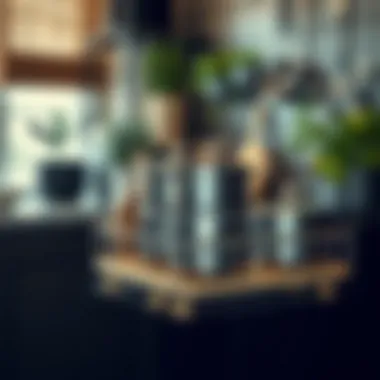

Utilizing Shelves
Shelving provides an opportunity to display or access your pots without hindrance. The choice between open or closed shelves can greatly impact how your kitchen looks and feels. Each has its own set of pros and cons, relevant to different cooking styles and aesthetic preferences.
Open vs Closed Shelving
Open shelving is popular in modern kitchens. It allows you to store pots in plain sight, creating a rustic, organic vibe. The primary benefit is easy access; you can grab what you need swiftly when cooking. Plus, it becomes a showcase for your beautiful cookware, effectively making your kitchen feel more welcoming.
However, there are downsides to consider; open shelves can lead to dust accumulation and potential clutter if not maintained regularly. You might need to rearrange occasionally to keep a clean look. Closed shelving, on the other hand, offers protection and a more organized appearance, keeping dust at bay.
Adjustable Shelf Systems
Adjustable shelf systems introduce flexibility into pot organization. By being able to alter the shelf heights, you can tailor your storage space specifically to suit the size of your pots. This adaptability is vital, especially in homes where pots come in various shapes and sizes.
The main characteristic of these shelving systems is their versatility. You can rearrange your shelves as needed, adapting to your collection's evolvement over time. This can be a beneficial approach for those who like to collect unique kitchenware or strive to keep a streamlined cooking process.
Nonetheless, the downside might be added complexity during installation, and some systems may lack sturdiness unless properly secured. However, for those who want to keep their options open, adjustable shelf systems can be a great addition.
Finding the right balance between aesthetics and functionality in pot organization ultimately leads to smoother cooking experiences and a more inviting kitchen environment.
Creative DIY Pot Organizers
Creative DIY pot organizers can make a world of difference in how efficiently space is used in homes, particularly in small kitchens or crowded garden sheds. This section dives into both the resourcefulness and satisfaction that arises from using everyday items in innovative ways to keep pots organized. There are practical benefits to such solutions–from saving money to reducing waste–that resonate with those keen on style and functionality. By incorporating elements that speak to creativity, these organizers not only serve a purpose but also add an artistic touch to any space.
Repurposing Household Items
Old Drawers as Storage
Old drawers are the ultimate example of repurposed materials that can efficiently store pots. Instead of letting those unused drawers gather dust, they can be transformed into charming organizers. These drawers add layers of storage solutions without requiring significant investments. One of the most appealing characteristics of these is their versatility; they can be stacked, mounted on the wall, or simply placed in cabinets.
Using an old drawer means you may get a one-of-a-kind piece, enhanced with its own history. However, one must consider that the size and shape of drawers can vary significantly, lending to either awkward adaptations or fitting in where they belong seamlessly. An advantage here is that they can be painted or stained to match existing decor, making them not just practical but aesthetically pleasing as well. But, bear in mind, if left untreated, older wood might harbor dust or pests.
Using Crates and Baskets
Crates and baskets serve as practical storage that carries a rustic charm. They are readily available at thrift stores or can be purchased brand new. Their open design allows you to see at a glance what you have, which is particularly useful in busy environments. They are easily stackable, lending themselves to vertical storage.
The beauty of baskets hinges on their material; wicker tends to evoke thoughts of coziness, while plastic crates can bring in a more modern vibe. This choice undoubtedly highlights both form and function. However, it’s important to consider that while their aesthetic appeal is undeniable, maintenance can be tricky. Wicker may require cleaning to avoid degradation over time, while plastic may fade under direct sunlight.
Building Custom Solutions
Wooden DIY Plans
Wooden DIY plans present another creative route for pot organization, allowing individuals to channel their inner craftsman. Building custom wood organizers enables a tailored fit for specific spaces and needs. Homeowners and enthusiasts can design shelves or multi-tiered stands to hold pots of varying sizes efficiently. The enduring characteristic of wooden organizers is their durability; with the right kind of wood and proper finishing, these can last for years.
One significant benefit is that wood can be sourced easily, often processed from recycled materials. Constructing these pieces can be a rewarding venture, turning an idea into a tangible product that meets specific demands. However, the challenge lies in the ability and tools needed for assembly. Novice builders may find themselves stumped if they lack a plan or the necessary skills.
Metal Pipe Shelving
Metal pipe shelving is an innovative and industrial approach to pot storage. This method of organization fuses functionality with an urban aesthetic that suits modern homes quite well. The concept behind using metal pipes revolves around providing robust support for heavier pots. One can easily rearrange or customize pipe shelving to maximize space utilization and accommodate different pot sizes.
A standout feature of this approach is its sturdiness. Pipe shelving can hold significant weight without the risk of bending or breaking. However, drawbacks include the complexity of assembly; it often involves precise measurements and fittings. Additionally, over time, metal may become susceptible to rust, which can compromise both the appearance and integrity of the shelving. This is why proper maintenance and eventual covering are essential for longevity.
Ultimately, whether through repurposing household items or crafting custom shelves, getting creative with pot organization can effectively address space constraints while expressing personal style.
Vertical Storage Techniques
Utilizing vertical storage is a game changer when it comes to organizing pots and maximizing space in your home. This approach not only increases storage efficiency but also adds a stylish touch to your decor. By making use of wall and ceiling spaces, homeowners can free up valuable horizontal real estate, creating a more open and functional living area.
Wall-Mounted Organizers
Floating Shelves for Pots
Floating shelves are an innovative and effective storage solution for pots that can contribute significantly to achieving an organized kitchen or living space. These shelves are anchored directly to the wall, giving the illusion that they are ‘floating’ without visible support. Their minimalist design enhances the aesthetics of a room, allowing you to display your pots elegantly.
One key characteristic of floating shelves is their versatility; they can be installed at varying heights, making them an ideal choice regardless of the kitchen or space layout. Homeowners have appreciated the flexibility floating shelves provide, enabling them to showcase plants or pots that complement the interior design.
However, while advantageous, floating shelves have some disadvantages. Visibility can lead to dust accumulation, requiring more frequent cleaning. Additionally, these shelves have a weight limit, which can restrict the number of pots or larger items you can place.
Hanging Rack Systems
Hanging rack systems also stand out as a practical approach in pot organization. These systems typically consist of a framework suspended from the wall or ceiling, allowing pots to be suspended from hooks or rails. Their most appealing aspect is the ease of access. Home cooks love having their pots literally at their fingertips, effortlessly grabbing what they need without rummaging through a cabinet.
The unique feature of hanging racks is their ability to keep pots clear of countertops, which can facilitate easier meal prep and cleaning. They are particularly useful in smaller kitchens where space is tight. One downside to consider is that hanging racks can require more installation work compared to other solutions, and not everyone prefers this open storage method, as it makes pots more visible and less concealed.
Using Ceiling Space
Utilizing ceiling space is another innovative strategy for pot storage, expanding options beyond traditional shelving.
Hanging Chains and Hooks
Hanging chains and hooks present a practical solution for accessing pots while keeping them out of the way. This method involves chains connected to the ceiling, with hooks that securely hold pots and pans. The upside is utilization of otherwise wasted space, freeing up valuable kitchen cabinet storage.
A key characteristic of this approach is its adaptability. Homeowners can adjust the height of the chains and hooks to accommodate their needs, allowing even taller pots to hang without restriction. On the flip side, visibility can mean pots are subject to dust, similar to other forms of open storage.
Pot Racks Above Kitchen Islands
Pot racks installed above kitchen islands are an attractive and functional option for storing pots. These racks serve as a centerpiece in many kitchens, providing both storage and style. The open design allows pots to be easily accessed while also displaying them as part of the kitchen decor.
The primary advantage of pot racks above kitchen islands is their dual functionality, blending organization with aesthetic enhancement. However, they require adequate ceiling height to ensure comfort while cooking, and they may also limit overhead space—for instance, light fixtures or other hanging items might be affected. Despite the challenges, many homeowners view this type of organization as a worthy investment to optimize space.
"Using vertical storage techniques can open up your kitchen, making it not only more orderly but also visually appealing."
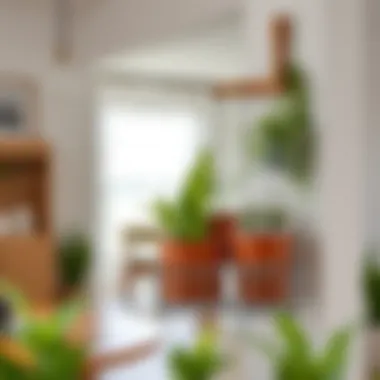

In consideration of these vertical storage techniques, it's evident that creatively utilizing space can dramatically enhance both functionality and aesthetics in any room. Choosing the right solution hinges on individual needs and the specific layout of the space, allowing homeowners to tailor their storage solutions effectively.
Innovative Storage Solutions
Innovative storage solutions are the cornerstone of effective space utilization, particularly when it comes to organizing pots in a stylish yet functional manner. It's not just about storing pots; it's about maximizing limited space and maintaining an aesthetic that complements the overall design of the home. These innovative approaches can significantly enhance the organization of pots while making the best use of vertical, horizontal, and even hidden spaces.
Integrated Furniture Options
Furniture with Built-In Storage
Furniture with built-in storage is a brilliant way to consolidate your possessions without adding clutter to your living area. For instance, a coffee table that includes compartments or drawers can hold pots and pans, keeping them neatly tucked away, yet easily accessible. Such designs are not just practical but can seamlessly blend into any interior decor, making them a favorite among many homeowners.
The key characteristic of this type of furniture is its dual function—serving both as a piece of furniture and as a storage unit. This makes it a popular choice for those who value efficiency without compromising style.
One unique feature of built-in storage furniture is the adaptable design often found in modular setups. Such designs allow owners to customize their storage solutions according to their specific needs or the evolving demands of their space. A drawback may include potential higher costs compared to standard furniture, but the long-term benefits generally outweigh the initial investment.
Multi-Functional Tables
Multi-functional tables are another innovative and practical solution for pot organization. These tables are designed to serve multiple purposes, such as serving as a dining area, workspace, or even a flower pot display. Their versatility makes them indispensable in homes where maximizing space is essential.
Being able to transform these tables from one use to another is their standout feature, making them extremely valuable in smaller areas. Imagine a dining table that can also function as a potting table when needed. This adaptability is why multi-functional tables gain popularity, especially in urban living situations.
However, it's important to consider that the transformation mechanisms may require some effort to set up. Depending on the design, they may consume more floor space when expanded. Despite this, the efficiency gained through their utility offers substantial rewards for homeowners looking to enhance their pot organization.
Smart Organizers
Magnetic Systems
Magnetic systems provide a modern approach to pot organization that is both innovative and intuitive. These systems work effectively for metal pots or those with magnetic bases, holding them securely in place while keeping them visible and accessible. This is particularly useful in kitchens where space is typically at a premium.
A notable characteristic of magnetic systems is their space-saving capability. By using vertical space efficiently, these systems allow pots to be stored on walls or appliance sides instead of taking up counter or cupboard space. This open visibility can make meal prep easier, as items are readily at hand.
The unique advantage of these systems is that they can be easily adjusted. Homeowners can reposition storage as their collection changes, or even add decorative magnetic elements. However, one downside is the limitation of compatibility; not all pot types will work with these systems, which means users may need to keep additional storage options in mind.
Suction Cup Storage Solutions
Suction cup storage solutions offer an intriguing alternative for organizing pots, especially in kitchens or bathrooms. They utilize suction technology to attach to non-porous surfaces, allowing pots to be mounted wherever space is available. This means pots can be placed on walls or inside cabinet doors, further maximizing every inch of potential storage space.
The standout feature of suction cup solutions is their ease of installation. No tools are required; you can place or remove them as needed without damaging walls or cabinets. This flexibility makes it an enticing option for renters or anyone who prefers to avoid permanent fixtures.
However, a consideration is that suction cups may lose adherence over time, especially if not cleaned regularly or if the surface becomes wet. Thus, while they offer innovative benefits for organization, they require occasional maintenance to ensure they hold up.
As the pursuit for efficient pot organization continues, innovative storage solutions like these pave the way for creativity and functionality, ensuring homeowners can enjoy their spaces to the fullest.
Sustainable Material Choices
When delving into pot organization solutions, the choice of materials plays a pivotal role, not just in terms of aesthetics but also in environmental impact. Opting for sustainable materials can reduce landfill waste, and lower carbon footprints, while enhancing the functionality of your pot organizers.
Using sustainable materials fosters a commitment to eco-friendliness and can contribute to a healthier indoor environment. It's about making smarter choices that align with a growing awareness of environmental responsibility. Here are some essential subtopics to consider, including recycled materials and natural finishes.
Recycled Materials
Using Upcycled Wood
Using upcycled wood stands as a prime example of sustainable practices. This kind of wood comes from existing products, meaning you're giving new life to materials that might otherwise be discarded. Upcycled wood isn’t just about being resourceful; it also imparts character to your pot organizers, each piece telling its own story. What makes it so appealing is that it often has unique textures and colors, distinguishing it from conventional lumber.
Nonetheless, while upcycled wood is generally a beneficial choice, its sourcing can be somewhat hit-or-miss. You may find great deals at local salvage yards or from renovations. However, it's essential to scrutinize the condition of the wood, ensuring no contaminants are present. This unique feature is appealing for DIY enthusiasts who appreciate the notion of sustainability intertwined with artistry.
Eco-Friendly Plastics
Turning to eco-friendly plastics opens another door towards sustainable pot organization. These materials are generally made from renewable resources or recycled content. Their appeal lies in durability and versatility. Unlike traditional plastics that can contribute to ocean pollution and landfill issues, eco-friendly options can be repurposed and recycled more easily.
While these plastics can be a popular choice, they can sometimes be more expensive than standard options. The trade-off often lies in the upfront cost versus the long-term benefits of durability and the environmental impact. Its unique quality of being lightweight and moldable allows for creative shapes and designs in pot organizers that are functional and visually appealing, enhancing both organization and decor.
Natural Finishes and Coatings
Non-Toxic Paints
Non-toxic paints represent a substantial advancement in the realm of pot organization. These coatings offer a way to add color and character without the headache of harmful fumes or toxic chemicals. Using non-toxic paints aligns perfectly with the goal of creating a healthy environment, especially for those storing kitchenware and pots. This characteristic makes such paints a beneficial choice, particularly for homes with children or pets.
The unique feature of non-toxic paints lies in their health advantages; they allow for safer indoor air quality and less adverse impact on human health. However, they can sometimes come at a higher price point, complicating budgets. Still, the worth often justifies the expense, as they promote both aesthetics and safety in your organizational efforts.
Natural Sealants
Natural sealants present an alternative way to protect your pot organizers while maintaining environmentally friendly standards. These products are derived from plants or minerals and help maintain the wood's integrity against moisture and wear. They are typically free from harmful chemicals found in traditional sealants, providing a harmless barrier.
Being a beneficial choice, natural sealants can offer the durability and protection you desire without the drawbacks of synthetic options. The unique feature of these sealants is that they often enhance the wood's natural visual appeal instead of obscuring it, allowing for a perfect marriage of function and beauty. A consideration, though, revolves around the need for more frequent applications compared to conventional sealants, which can affect long-term maintenance.
To wrap this section up, sustainable material choices are not merely a trend, but a necessary step towards a greener lifestyle. By choosing materials like upcycled wood, eco-friendly plastics, non-toxic paints, and natural sealants, you can create pot organizers that are both practical and aesthetically pleasing. This conscious approach ensures that in enhancing your space, you're also doing your part in caring for the planet.
Maintaining Order in the Pot Collection
Keeping a tidy and organized pot collection is fundamental for both functionality and aesthetic appeal within your living space. When pots are scattered and unkempt, they can quickly transform a charming kitchen or a vibrant garden area into a chaotic mess, potentially overshadowing the beauty of your plants. Effective organization not only saves time but also enhances the overall experience of gardening and cooking. It’s not enough to merely store pots; they should be arranged in a way that allows for both easy access and visual harmony.
Regular Audits of Pot Inventory
One of the most effective ways to maintain order is by performing regular audits of your pot inventory. This means taking a step back, periodically assessing what you have, and making decisions on what stays and what goes. Here’s how you can perform a straightforward audit:
- Take Stock: Gather all your pots in one area. You’d be surprised how many pots you accumulate over time. Check for duplicates or broken items that no longer serve a purpose.
- Categorize: Group your pots based on size, type, or even color. For example, all terracotta pots in one section, and all ceramic in another. This not only looks pleasing but also makes it easier to find what you need.
- Clean and Prune: Ditch any dusty pots and clean the ones you intend to keep. This gives them a refreshed look. Also, check the plants; if any have outgrown their pots, it's time to repot.
- Document: A simple inventory list can be created, noting what pots you have and their condition. This will help you avoid buying pots you don’t need and keep your collection truly functional.
Regular audits don’t just keep your collection tidy—they also provide an opportunity to rethink your gardening approach. Maybe you realize that you need larger pots for certain plants or that a particular style does not align with your current décor.
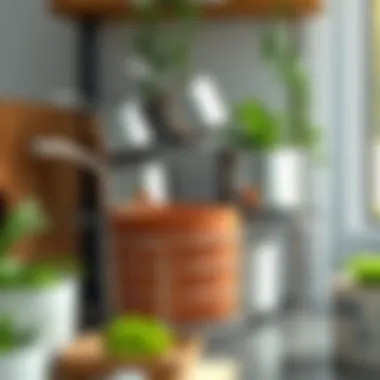

Seasonal Organization Tips
The changing seasons can also be a window of opportunity for reorganizing your pots. As the temperature shifts, so do your gardening needs. Here are some tips to keep in mind for seasonal adjustments:
- Spring Refresh: At the start of spring, as new plants begin to emerge, it’s a great time to clean out pots that may have wintered unused. You can also implement a rotation system, placing your vibrant spring blooms in the most visible spots.
- Summer Downsizing: During the hot summer months, you might find that certain plants thrive while others don't. Use this time to thin out your collection. Plants that don't perform well often get shaded out; consider giving them away or selecting pots that complement lighter colors for sunlit areas.
- Fall Prep: As plants will eventually go dormant, think about how to store pots that may need a break. Switching decor can refresh the look of your space, with autumn colors reigning supreme.
- Winter Storage: When temperatures dip, it’s essential to check your ceramic and terracotta pots, as they can crack due to cold. Consider moving them indoors or to a sheltered area. If you have plastic pots, take advantage of this time to declutter and store them where they won’t take space unnecessarily.
"An organized pot collection is not just a visual treat, it brings peace of mind. It allows one to focus on what truly matters—nurturing the green life that brings us such joy."
By maintaining order through these audit practices and seasonal reorganizations, your pot collection can remain an inspiring and functional part of your environment. This commitment not only enhances the aesthetics but also enriches the entire experience of nurturing plants.
Enhancing Aesthetic Appeal
A pot organizer is not merely a functional addition to your home; it is also an opportunity to express your personal style and enhance the visual appeal of your space. When you put thought into the way pots are organized, you not only promote efficiency but also contribute to the overall decor of your kitchen or living area. This section delves into practical ways to harmonize colors and patterns in your pot organization, as well as incorporating decorative elements that resonate with your style.
Harmonizing Colors and Patterns
Choosing a color scheme for your pot organization is like crafting a piece of art. The right colors can transform an ordinary setup into something striking. Here are a few pointers to consider when harmonizing colors and patterns in your pot arrangement:
- Complementary Colors: Select pot colors that align with or complement your existing decor. For instance, if your kitchen has a rustic theme, consider using earthy tones and natural materials that mirror the environment.
- Monochromatic Schemes: A monochromatic palette can also be visually pleasing. Different shades of a single color can create a sophisticated look while maintaining a cohesive design. Think pastel shades – soft greens or blues can promote a serene atmosphere in your cooking space.
- Patterns with Purpose: Using patterned pots can be a fun way to introduce some vitality into your setup. Just make sure they don’t clash with existing patterns in your space. It’s a bit like a dance; balance is key.
"Color is a power which directly influences the soul." – Wassily Kandinsky
Incorporating Decorative Elements
Once you’ve established a thoughtful color scheme, the next step is bringing in decorative elements. These small touches can drastically enhance the aesthetic appeal of your pot organization:
- Seasonal Decor: Swap out pots as the seasons change. Bright, floral ceramic pots are perfect for spring and summer, whereas darker, textured materials work well for autumn and winter. This not only keeps the aesthetic fresh but also connects your organization to the time of year.
- Artistic Display: Consider using open shelving where pots are displayed as art pieces. When pots are part of the visual landscape, they can elevate the whole environment. You might include personal touches like family heirlooms or handcrafted items to add character.
- Natural Elements: Incorporating elements such as wood or stone can ground the space. For instance, placing a terracotta pot on a wooden board creates a striking contrast that draws the eye.
- Lighting: Don’t forget about lighting! Strategically placed LED lights can accentuate the beauty of your pot collection. A softly lit space can enhance colors and textures, creating an inviting atmosphere.
In summary, enhancing aesthetic appeal in your pot organization is about creating a dynamic visual experience. When your pots are not just stored but displayed beautifully, they become an integral part of your home’s decor, aligning form with function.
Case Studies in Pot Organization
Importance of Case Studies in Pot Organization
Understanding what works and what doesn’t can be a game-changer for anyone trying to get a grip on pot organization. Case studies provide real-world examples that shed light on the practical implications of various storage strategies. They give readers a lens into common obstacles faced by homeowners and designers alike, and how those hurdles were tackled with innovative solutions. This is important because it shows the effectiveness of different approaches, offering inspiration and practical advice for your own organization endeavors.
Moreover, these narratives can highlight diverse styles and preferences that suit various spaces, from cozy apartments to spacious kitchens. They also help in understanding the emotional impact of a well-organized space—how it transforms not just the look but also the feel of a home. Case studies serve as a guidebook, helping you avoid pitfalls and elaborate on the successes of others. By exploring real-life scenarios, readers can refine their own organizational habits, ultimately saving both time and frustration.
Homeowner Testimonials
When we hear directly from homeowners who have tackled the challenge of pot organization, it adds a relatable layer to our understanding. Take, for instance, a homeowner named Lisa in San Francisco, who faced mounting clutter in her kitchen cabinet overflowing with pots. "I was constantly digging through layers of pans, and it was a real pain point for cooking," she recalls.
After implementing a modular shelving system, Lisa transformed her storage. "Now, everything has its place," she explains. The open layout allows for easy access, and the sleek design complements her kitchen decor seamlessly. Her story demonstrates how innovative pot organizers can not only enhance functionality but also maintain aesthetic appeal.
Another example comes from Miguel in Austin, who decided to repurpose old crates as a way to display his pots. He enjoyed the rustic vibe it brought to his kitchen. "Using crates helped me craft a unique look while keeping everything organized," he shared. These testimonials reveal that practical solutions can align with personal style, emphasizing that pot organization isn’t just about utility—it’s also about expressing individuality.
Successful Designer Implementations
The insights from professional designers can be invaluable when trying to tackle pot organization. Designers often think outside the box, crafting solutions that blend beauty and practicality, elevating spaces to new heights. For instance, a recent project by a well-known designer in New York City involved a stunning kitchen renovation. They incorporated a vertical storage solution by utilizing a combination of wall-mounted racks and glass-front cabinets. Not only did this provide ample space, but it also created a focal point that attracts the eye.
These designer implementations often consider the bigger picture—how each piece interacts with light, color, and even texture. A successful installation by a designer in Los Angeles combined open shelving for pots with integrated lighting beneath the shelves, creating a warm, inviting atmosphere at night. "The way the pots catch the light really adds character to the space," the designer noted. This careful consideration of design elements exemplifies how organized pot storage can become an integral part of a home’s aesthetic rather than just an afterthought.
By examining the successes of designers, homeowners can glean inspiration and practical tips for their own spaces, helping to cultivate organized and beautiful environments.
The End and Future Trends
In considering the myriad of pot organization strategies, it's clear that effective space utilization is not merely a matter of aesthetics but also a testament to functional design. The final thoughts on this subject reflect both the current landscape and the exciting possibilities ahead for homeowners and designers alike.
The trends shaping this field reveal a shift towards solutions that merge function with artistry. For instance, vertical storage options, which prioritize both style and space, are increasingly gaining traction. It's not just about cramming as much as possible into tight corners anymore; the focus is on creating an inviting and accessible display of pots that enhances the overall interior design.
Key Considerations for Future Trends:
- Sustainable Materials: As eco-consciousness grows, expect to see a rise in the use of recycled materials for pot organizers, aligning with the broader trend of sustainable living.
- Smart Home Integration: Also on the horizon is the integration of technology in storage solutions. Imagine organizers that not only hold your pots but can also notify you when items are out of reach or need replenishing, making organization smarter, easier and increasingly relevant in today's digital age.
- Custom Solutions: The emphasis on unique interiors means that there's likely to be more demand for custom pot organizers tailored to individual needs and preferences, transcending conventional designs.
Emphasizing the importance of innovative pot organization is crucial; it ensures that living spaces are both functional and visually appealing.\nHomeowners will need to stay ahead of these trends, adapting to what works best in their unique spaces as the realm of pot organization continues to evolve. The future is about balance—creating environments that not only serve their intended purpose but also spark joy and reflect personal style.
Looking Ahead in Pot Organization
As we drift further into an era defined by minimalism mixed with creativity, the future of pot organization appears bright. Having organized pots doesn’t just mean stowing them away; it means taking the time to understand how each piece fits into the larger narrative of your space.
Emerging Trends to Keep an Eye On:
- Modular Systems: There is a mounting interest in modular designs that allow for adaptable configurations. Whether some pots may require more space than others, modular units can be customized easily, accommodating changing needs without a full redesign.
- Biophilic Design: Engaging with elements of nature—including plant displays within the living space—will likely see a rise as well. Expect pot organizers that double as vertical gardens or shelf systems that introduce a lushness to utilitarian spaces.
- Community Solutions: More homeowners may look into shared spaces or community gardening projects. Organizers designed for communal use could foster connections within neighborhoods while maximizing pot storage efficiency.
The journey forward in pot organization isn't linier but filled with opportunities for creativity and personal expression. With these trends, the field can evolve, helping homeowners create spaces that resonate with both their functional needs and aesthetic desires.
Q&A on Pot Organizer Choices
As the conversation continues about how to best store pots while maintaining style and layout, it is essential to address common queries that arise among homeowners and design enthusiasts alike. Here’s a selection of frequently asked questions:
What’s the best type of organizer for small spaces?
- Answer: For small spaces, vertical storage solutions like wall-mounted racks or floating shelves tend to be the most effective. They utilize upward space and keep pots accessible without hogging precious floor space.
How can make my pot organizer more decorative?
- Answer: Consider adding personal touches like paint colors or patterns that harmonize with your home's decor. Incorporating decorative baskets or stylish labels also promotes aesthetic appeal while keeping functionality in check.
Are there any specific materials recommended for pot organizers?
- Answer: Wood is always a popular choice due to its versatility and warmth, but don't shy away from using metal or durable plastics, particularly if they offer a sleek, modern look. The choice should depend on your existing decor and personal style.
How do maintain order in my pot collection?
- Answer: Regularly scheduling audits of your pots prevents clutter. Keep track of what you have and assess whether your organizers need adjustments based on your inventory.
Engagement with these questions not only simplifies the decision-making process but also helps to foster a deeper understanding of the various options available to the discerning pot enthusiast.










